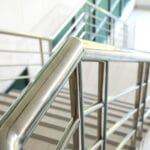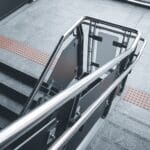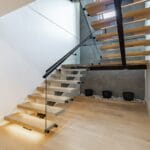Introduction
The building standards (RBQ) for stairs, handrails, and balconies are essential elements to ensure the safety and compliance of residential and commercial structures in Québec. These rules, integrated into the Québec Construction Code, define construction and installation criteria to ensure user safety and the durability of structures. Their importance lies not only in complying with the law: they protect against accidents, extend the useful life of structures, and strengthen occupants’ confidence. Regularly updated, they reflect best practices and technological advances in the field of metal and architectural construction.
Key Summary
| Element | Essential RBQ Standard |
| Interior stairs | Riser height: 14.6 to 20 cm; minimum tread depth 23.5 cm; minimum width 86.4 cm |
| Stair guardrails | Minimum height: 90 cm |
| Balconies | Guardrail required starting at 61 cm in height; minimum 91.5 cm for a balcony more than 1.83 m high |
| Handrails and railings | Required starting at 3 risers; height 91.5 cm; minimum distance from wall 3 cm |
| Exterior stairs | Minimum width 86 cm; step depth 23.5 to 35.5 cm |
| Compliant materials | Galvanized steel, stainless steel, aluminum, treated wood, composites |
| RBQ license | Mandatory for any contractor installing stairs, handrails, and balconies |
Why are RBQ standards important?
RBQ standards are essential because they ensure occupant safety and the quality of structures. They set precise criteria regarding dimensions, materials, and installation methods. Complying with them helps avoid design errors that could lead to serious accidents or costly renovations. These standards also provide assurance for owners, who know their installations meet recognized standards. By following the Code, contractors ensure they build structures that are durable, safe, and suited to the intended use, whether for residential, commercial, or public buildings.
Standard dimensions for interior stairs
The Québec Construction Code specifies minimum and maximum dimensions to make stairs safe and comfortable.
- Headroom height: 1.95 m (76 ¾ in.).
- Risers: between 14.6 and 20 cm, with a common standard at 19 cm.
- Nosing: minimum 2.5 cm (1 in.).
- Tread depth: at least 23.5 cm (9 ¼ in.), usually between 25.4 and 30.5 cm (10 to 12 in.).
- Minimum width: 86.4 cm (34 in.).
- Maximum distance between stringers: 120 cm (47 ¼ in.).
These dimensions ensure accessible stairs suited to all users, including children and older adults.
Criteria for treads and risers
Treads and risers must meet several criteria to ensure regular ascent and descent. Uniform riser height is a key factor in avoiding missteps. Tread depth must provide comfortable foot support. These requirements reduce the risk of falls and contribute to user comfort. A staircase that does not comply with these rules can feel unstable and pose a danger, even if the difference seems minimal.
Minimum height of guardrails
According to the RBQ, the minimum height of stair guardrails is 90 cm (35.4 in.). For balconies, a guardrail is required as soon as the fall height is greater than 61 cm (2 ft). If the balcony is 1.83 m (6 ft) or more above the ground, the minimum guardrail height must reach 91.5 cm (42 in.). These measures are designed to prevent accidental falls and effectively protect users. Failure to meet these requirements poses a major safety risk.
Handrails and railings
Handrails and railings play a crucial role in user stability. A handrail is mandatory once a staircase has more than three risers. Their height must be 91.5 cm (36 in.), measured from the nosing, and they must be installed at least 3 cm from the wall to allow a good grip. Railings must also withstand a lateral load of 50 pounds per linear foot to ensure solidity. These requirements reduce the risk of slips and provide essential support for people with reduced mobility.
Differences between interior and exterior stairs
Exterior stairs are subject to specific constraints related to weather and wear. The minimum width is the same as for indoors (86 cm), but the depth of exterior steps must be between 23.5 and 35.5 cm (9.5 and 14 in.). Handrails are required for exterior stairs with more than three risers. These wider tolerances take into account climate variations, snow accumulation, and the need to ensure comfortable footing even under difficult conditions.
| Element | Interior stairs | Exterior stairs |
| Minimum width | 86.4 cm (34 in.) | 86.4 cm (34 in.) |
| Step depth | Minimum 23.5 cm (9 ¼ in.) | 23.5 to 35.5 cm (9.5 to 14 in.) |
| Handrails | Required starting at 3 risers | Required starting at 3 risers |
| Specific constraints | Comfort and ergonomics | Resistance to weather and ice |
Recommended materials for handrails and guardrails
Materials accepted by RBQ standards must ensure both durability and safety. Among the most used are aluminum, galvanized steel, stainless steel, treated wood, and composites. These materials better resist weather and corrosion. The use of untreated wood or non-galvanized steel is strongly discouraged, as it can lead to rapid deterioration and compliance issues. The choice must also consider aesthetics to harmoniously integrate handrails and guardrails into the building’s design.
Balcony compliance
To ensure balcony compliance, the Code requires a guardrail as soon as they are more than 61 cm above the ground. Its minimum height must be 91.5 cm for balconies located more than 1.83 m high. In addition to meeting these dimensions, it is essential to regularly check the integrity of materials and fasteners. Preventive inspections help ensure the structure remains safe over time, particularly given the frequent freeze–thaw cycles in Québec.
Risks related to non-compliance
Ignoring RBQ standards can have serious consequences. In addition to financial penalties, site closures, or compliance orders, non-compliance directly exposes users to accident risks. A fall caused by a guardrail that is too low or a poorly designed staircase can result in serious injury and engage the legal liability of the owner or contractor. Complying with standards therefore protects both occupant safety and the reputation of the professionals involved.
RBQ license and importance for contractors
An RBQ license is mandatory to install stairs, handrails, and balconies in Québec. It certifies that the contractor has the technical and legal skills needed to carry out the work in accordance with standards. This license protects consumers and ensures projects are carried out by qualified professionals. For an owner, verifying the validity of this license is a guarantee of confidence and peace of mind.
New standards for residential pools in 2025
Starting September 30, 2025, all residential pool owners will have to comply with new safety standards. These rules aim to reduce the risk of drownings and accidents. They will include strengthened requirements for fences, alarm devices, pool covers, and barrier height. These changes reflect a desire to improve the prevention of household accidents, particularly among children. Owners should therefore anticipate these obligations to plan their layouts and avoid penalties.
Variations depending on building type
Regulations for railings vary depending on building type. For a single-family home, a railing is required as soon as a staircase has more than three risers. In apartment buildings or commercial buildings, requirements are often stricter due to user volume. For example, stair widths may be increased, and guardrails must be reinforced. These differences aim to ensure the safety of a larger number of people in varied traffic contexts.
Tips to avoid construction errors
To avoid common errors, it is recommended to carefully plan the work, strictly follow RBQ standards, and use only compliant materials. Hiring a qualified professional is the best guarantee of compliance. A detailed review of plans before the start of the worksite, as well as regular inspections, helps prevent installation defects and ensure the structure’s longevity. The savings from skirting certain rules are often illusory, as rework and corrections cost much more in the long term.
Importance of building inspections
Inspections are an essential part of maintaining the safety of structures. They make it possible to verify that the work complies and to detect signs of wear or deterioration. By identifying problems early, repairs can be carried out before they become critical. Regular inspections therefore provide an ongoing safety guarantee and strengthen occupants’ confidence.
Conclusion
RBQ standards for stairs, handrails, and balconies provide an essential framework to ensure the safety and durability of buildings in Québec. By respecting dimensions, choosing the right materials, and entrusting the work to licensed contractors, owners and builders protect themselves from major risks. With constantly evolving rules, staying informed is essential.
Planning a project involving stairs, handrails, or balconies? The experts at Metanox, specialized in custom metal design and fabrication, can support you to ensure compliance, safety, and aesthetics for your projects.


















